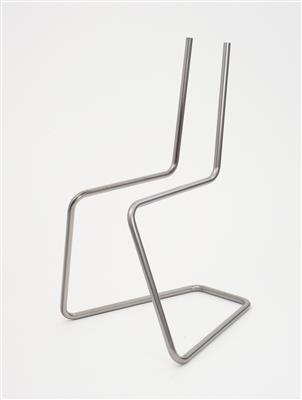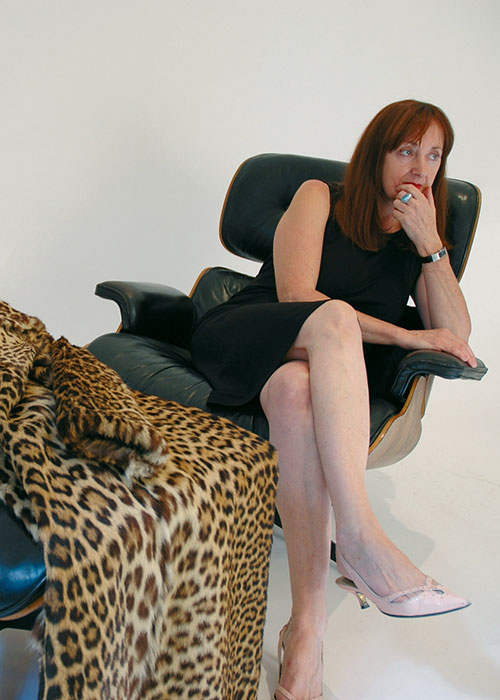A ‘Steel Tube Bending’ chair, Model No. 1, Thomas Feichtner

2013, for Thonet, Germany, and BLM Group, Italy, bent tubular steel, signed and numbered: Thomas Feichtner 12/120 and inscribed: Chair No. 012 Date 13 11 13/Steel tube bending/an installation by Thomas Feichtner/Hofburg/Vienna/Austria / 2013/in cooperation with THONET, BLM, WOHNDESIGN PURE, height 85 cm, width 55 cm, depth 53 cm, height of seat 50 cm. (DRAX)
No. 12 from a performance at the Vienna Wiener Hofburg, in which altogether ten chairs were produced, each in an edition of 12.
When Mart Stam presented a merely skeletal system of screwed-together metal pipes in 1926, it was not only the birth of the cantilever chair, but also the beginning of the furniture industry’s use of bent tubular steel. Today, nearly 90 years later, robots can shape pipes however one wishes—and Austrian designer Thomas Feichtner, together with THONET and tube bending machine manufacturer BLM, has set out to explore the limits of present-day bending technology. This experimental process gives rise to various seating objects of which each consists of only one steel pipe, bent by a computer-guided robot within just a few seconds. This technology is used primarily in mass production, although it would certainly be capable of producing individual pieces. And this is precisely where Feichtner begins with his experiment of programming various seating objects from a single “line.” The nearly five-ton CNC bending machine can be used to bend a limited and numbered series right then and there. The focus of this experiment is not on its output alone (the object), but also on the process by which the object is made as well as the historical context. “It fascinates me that, by just entering X, Y and Z coordinates, a constructive body can arise within just a few seconds without any handwork whatsoever. It’s essentially ‘rapid prototyping’ in steel,” says Feichtner.
Specialist: Dr. Gerti Draxler
 Dr. Gerti Draxler
Dr. Gerti Draxler
+43-1-515 60-226
gerti.draxler@dorotheum.at
05.06.2014 - 18:00
- Estimate:
-
EUR 9,000.- to EUR 12,000.-
A ‘Steel Tube Bending’ chair, Model No. 1, Thomas Feichtner
2013, for Thonet, Germany, and BLM Group, Italy, bent tubular steel, signed and numbered: Thomas Feichtner 12/120 and inscribed: Chair No. 012 Date 13 11 13/Steel tube bending/an installation by Thomas Feichtner/Hofburg/Vienna/Austria / 2013/in cooperation with THONET, BLM, WOHNDESIGN PURE, height 85 cm, width 55 cm, depth 53 cm, height of seat 50 cm. (DRAX)
No. 12 from a performance at the Vienna Wiener Hofburg, in which altogether ten chairs were produced, each in an edition of 12.
When Mart Stam presented a merely skeletal system of screwed-together metal pipes in 1926, it was not only the birth of the cantilever chair, but also the beginning of the furniture industry’s use of bent tubular steel. Today, nearly 90 years later, robots can shape pipes however one wishes—and Austrian designer Thomas Feichtner, together with THONET and tube bending machine manufacturer BLM, has set out to explore the limits of present-day bending technology. This experimental process gives rise to various seating objects of which each consists of only one steel pipe, bent by a computer-guided robot within just a few seconds. This technology is used primarily in mass production, although it would certainly be capable of producing individual pieces. And this is precisely where Feichtner begins with his experiment of programming various seating objects from a single “line.” The nearly five-ton CNC bending machine can be used to bend a limited and numbered series right then and there. The focus of this experiment is not on its output alone (the object), but also on the process by which the object is made as well as the historical context. “It fascinates me that, by just entering X, Y and Z coordinates, a constructive body can arise within just a few seconds without any handwork whatsoever. It’s essentially ‘rapid prototyping’ in steel,” says Feichtner.
Specialist: Dr. Gerti Draxler
 Dr. Gerti Draxler
Dr. Gerti Draxler
+43-1-515 60-226
gerti.draxler@dorotheum.at
|
Buyers hotline
Mon.-Fri.: 10.00am - 5.00pm
kundendienst@dorotheum.at +43 1 515 60 200 |
| Auction: | Design |
| Auction type: | Saleroom auction |
| Date: | 05.06.2014 - 18:00 |
| Location: | Vienna | Palais Dorotheum |
| Exhibition: | 30.05. - 05.06.2014 |
Lots from other auctions
- Gabriel Cornelius Ritter von Max
- 1993 Bienvenues Bâtard-Montrachet Grand Cru AOC, Domaine Leflaive, Burgund, 93 Cellar Tracker-Punkte
- 1994 Romanée-St. Vivant Grand Cru AOC Marey-Monge, Domaine de la Romanée-Conti, Burgund, 91 Cellar Tracker-Punkte
- Konvolut Korallen (beh.) Perlmutt (5)
- 2 Zuckerstreulöffel,
